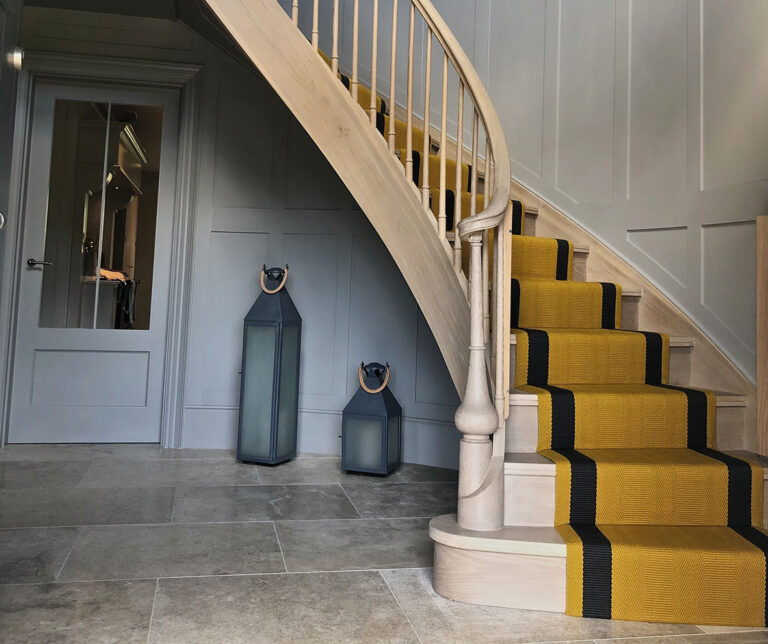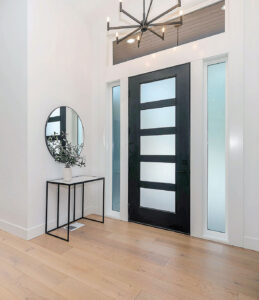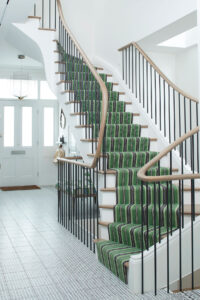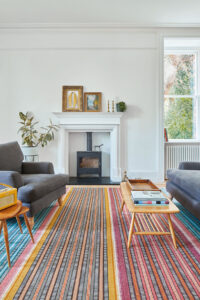Make an entrance
Posted 19th June 2023
This month Rosie Kinsella explores the often neglected yet crucial aspect of interior design: the hallway.
Rather than focusing solely on individual rooms, consider the entire house as a cohesive unit. Hallways, often regarded as transitional spaces, have the potential to make a lasting impression and serve as stunning entrances. From flooring choices that connect different areas to clever storage solutions, this article explores some practical tips for maximising your hallway’s functionality and aesthetic appeal. Additionally, it highlights the significance of lighting, mirrors, and incorporating elements from adjacent rooms to create a harmonious flow. By treating the hallway as a distinct space and giving it the attention it deserves, homeowners can transform it into a remarkable entrance that sets the stage for the rest of the home.
Whether you are moving into a new house or renovating your existing one, it’s easy to concentrate on the interior design of each room individually, looking at the use of rooms in isolation, rather than considering the whole house and ensuring a cohesive design. Hallways often get neglected in the initial ideas phase, disregarded as a non-room, rather than the statement entrance they can prove to be if considered at the outset. Whilst hallways are certainly transitional spaces, they are the first room you see when you come into the house, they can set the scene for what’s to come and provide a glorious welcome home after a day spent out and about.

It’s easy to write off a hallway or to imagine that if you don’t have a grand staircase or a large or stately home that the hallway is unimportant. Any entrance, no matter what size or scale, can be beautiful, impactful and well-considered. Hallways can be used to link the individualised styles of the rooms that they lead into or help one fluid design style flow throughout the house. A hallway can be so much more than a thoroughfare, from the obvious place for clever storage solutions for coats and shoes, to an art gallery to show off your favourite pieces or photographs.
Firstly, acknowledge how the space is used and how often. Consider hard flooring rather than carpet, it’s much easier to clean and maintain. If you prefer carpet, then opt for sisal, jute or coir or a looped weave carpet that has no pile to be flattened. Try companies like Crucial Trading and Fibre Flooring. Where you can, use the same laminate, hardwood, luxury vinyl, porcelain or ceramic tile throughout the whole of your ground floor. If that’s not possible, or if you prefer to have carpet in a living room or study, then use your hard floor in all the other rooms that you can. Keeping the number of different types of flooring to a minimum and reducing the number of thresholds between doorways will ensure the rooms remain connected. Make sure the hallway flooring and any carpet complement each other by comparing swatches of each before committing to a choice. Area rugs can be used to add warmth and softness underfoot. These can be made to match by choosing the same carpet as your other spaces. Many companies (including Mills and Kinsella) offer whipping and binding services to make rugs using carpets from within their product offering.

Stair carpets receive more traffic than any other in your home, from bounding down them in the morning to traipsing back up them at the end of a hard day. Carpets are sold according to their durability so make sure you choose a heavy domestic carpet that’s suitable for stairs. If you like the idea of a partly covered staircase and have stairs that are built from a quality wood or that can be painted, then an eye-catching stair runner might be just the solution. Brands such as Roger Oates, Hartley & Tissier and Off The Loom have a huge range of flatweave stair runners in a magnificent array of colours, patterns and plains and they are much more resilient to traffic than normal carpet. A stair runner is a great opportunity to add flare and personality to your hallway, making your staircase a striking feature and helping to carry the colours of your interior from the bottom of your house, right up to the top.
When it comes to storage, the hallway does not have to be a dumping ground! Instagram, Tiktok, Pinterest and Facebook are all filled with clever storage hacks to help you turn even the smallest of nooks into effective and efficient shelving. Many homes now make use of under stairs storage. Most modern houses will have a cupboard already built in which is great for hiding away coats, bags, shoes or umbrellas. Build racking inside to maximise shoe storage and put hooks on the wall for coats, bags and wellies. If you don’t currently have this option or would prefer an upgrade to your existing provision then find a local joiner or cabinet maker to help. Pull out drawers or shoe and coat racks on trundle wheels made to specifically fit your space can make access easier and encourage everyone to buy into the concept of tidying away.
Hallways tend to be dark spaces, more so than any other room in the house, especially if they are smaller and lack a window, relying on light washing in from other rooms. You can brighten up the hallway space by making sure your front door has a glass panel within it, or by adding a tall narrow window next to your front door or a fanlight above it. Internally, replacing solid doors with glazed doors will help light flow through the hallway at all times of day, even when the doors are closed, so long as the lights are on or there’s enough daylight. Mirrors can help reflect light around the hallway. A statement mirror makes a great feature when placed above a console table, and floor length mirrors may be useful if you like to check your outfit before leaving the house and prefer not to traipse around in your shoes.

If you’re struggling to visualise a design, then consider the rooms that the hallway leads into and use those for inspiration. You might use the same colour wall paint as another room, or use a draught excluder made in the same fabric as your dining room chairs or living room cushions, sofa or curtains. If you love art, then hanging similar styles of art in your hallway to those in your principal rooms will be impactful. There are many clever ways you can help your hallway be the grand entrance it deserves to be, the key is to consider it’s styling from the outset and treat it like a room of its own.
Rosie Kinsella | Interior Designer | 01604 751262
